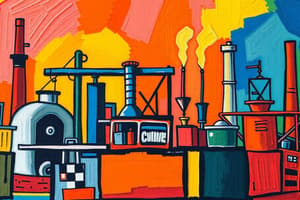Podcast
Questions and Answers
What is one disadvantage of an organizational structure that forces accountability at the top?
What is one disadvantage of an organizational structure that forces accountability at the top?
- Increases employee and manager morale
- Enhances delegation of authority
- Leads to short term, narrow thinking (correct)
- Encourages career development
Which of the following is a characteristic of the divisional structure?
Which of the following is a characteristic of the divisional structure?
- Minimizes career development opportunities
- Promotes delegation of authority (correct)
- Internal competition among divisions is non-existent
- Accountability can be unclear
What is a noted disadvantage of the matrix structure?
What is a noted disadvantage of the matrix structure?
- Improves communication between departments
- Violates the unity of command principle (correct)
- Duplication of functions is avoided
- Eases budget authority management
What is an advantage of the divisional structure?
What is an advantage of the divisional structure?
Which of the following is a disadvantage of a divisional structure?
Which of the following is a disadvantage of a divisional structure?
Why might the matrix structure be considered costly?
Why might the matrix structure be considered costly?
Which of the following advantages is not associated with the matrix structure?
Which of the following advantages is not associated with the matrix structure?
What is a disadvantage related to communication in the matrix structure?
What is a disadvantage related to communication in the matrix structure?
What is the first stage in the process of setting up a business?
What is the first stage in the process of setting up a business?
Which of the following best defines creativity?
Which of the following best defines creativity?
How can an organization improve its creativity according to the content?
How can an organization improve its creativity according to the content?
Which of the following is NOT a stage in setting up a business?
Which of the following is NOT a stage in setting up a business?
What is a distinctive feature of a creative organization?
What is a distinctive feature of a creative organization?
What is a common misconception about creativity at the individual level?
What is a common misconception about creativity at the individual level?
Which of the following techniques could help improve the creativity of a team?
Which of the following techniques could help improve the creativity of a team?
What does the process of determining the level of creativity refer to?
What does the process of determining the level of creativity refer to?
What does exclusive distribution involve?
What does exclusive distribution involve?
Which type of distribution allows for the product to reach as many markets as possible?
Which type of distribution allows for the product to reach as many markets as possible?
What is the primary purpose of promotion in marketing?
What is the primary purpose of promotion in marketing?
In the context of people in marketing, what role does customer service play?
In the context of people in marketing, what role does customer service play?
What does the process aspect of marketing focus on?
What does the process aspect of marketing focus on?
Which of the following is NOT a form of promotion mentioned?
Which of the following is NOT a form of promotion mentioned?
What is meant by 'physical evidence' in marketing?
What is meant by 'physical evidence' in marketing?
How does direct distribution differ from other distribution strategies?
How does direct distribution differ from other distribution strategies?
What is included in physical evidence?
What is included in physical evidence?
Which of the following best defines a production plan?
Which of the following best defines a production plan?
What is the first stage in the production process as defined in the content?
What is the first stage in the production process as defined in the content?
What does a production/operations plan communicate within an organization?
What does a production/operations plan communicate within an organization?
How does a production plan impact service delivery efficiency?
How does a production plan impact service delivery efficiency?
Which element is NOT considered part of a production plan's communication?
Which element is NOT considered part of a production plan's communication?
What role does a production plan play in managing materials and personnel?
What role does a production plan play in managing materials and personnel?
In manufacturing, what are the initial inputs for the production process?
In manufacturing, what are the initial inputs for the production process?
What is the main role of a financial plan in relation to a business plan?
What is the main role of a financial plan in relation to a business plan?
Which of the following is a type of equity financing?
Which of the following is a type of equity financing?
What is a key advantage of debt financing?
What is a key advantage of debt financing?
Which of the following is considered a source of finance?
Which of the following is considered a source of finance?
What is a major disadvantage of debt financing?
What is a major disadvantage of debt financing?
What describes a venture capitalist?
What describes a venture capitalist?
Which option is NOT a form of debt financing?
Which option is NOT a form of debt financing?
Which financing option involves selling company shares?
Which financing option involves selling company shares?
Flashcards are hidden until you start studying
Study Notes
Setting Up A Business
- The process of setting up a business involves three stages:
- Developing a business plan
- Acquiring finances
- Meeting legal requirements (including ownership, registration, and intellectual property rights)
- Organizations are increasingly seeking ways to improve creativity and efficiency to gain and maintain a competitive advantage.
- Creativity can be defined as the interaction of aptitude, process, and environment leading to a novel and useful product within a social context.
Creativity
- Individual Level: Associated with being artistic, generating new ideas, and solving problems.
- Societal Level: Associated with inventions, social programs, and scientific discoveries.
- Organizational Level: Is considered a function of creative outputs from individuals and contextual effects such as organizational culture, rewards, and resources.
- A creative organization is one whose primary income source comes from generating novel and suitable ideas, processes, products, or services to address client problems or opportunities.
Types of Organisational Structures
-
The Divisional Structure/ Decentralized Structure:
- Can be organized in four ways: by geographic area, by product/service, by customer, or by process.
- Advantages:
- Clear accountability
- Creates career development opportunities
- Promotes delegation of authority
- Leads to an internally competitive environment
- Allows for strict control and attention to products and customers.
- Disadvantages:
- Duplication of functional activities
- Can be costly
- Requires skilled management
- Internal competition between divisions can be dysfunctional
- Can lead to limited sharing of resources and ideas
-
The Matrix Structure:
- A complex structure with dual reporting. It depends on both horizontal and vertical flows of authority.
- Often used in construction, healthcare, and research.
- Advantages:
- Clear project objectives
- Easy to shut down a project
- Facilitates the use of special personnel
- Shared functional resources
- Disadvantages:
- Costly
- Violates the unity of command principle
- Creates dual lines of budget authority
- Requires excellent vertical and horizontal communication
- Creates shared authority and reporting
- Creates dual sources of rewards and punishment
The Marketing Mix (7 Ps)
-
Place: Where the product/service will be sold (e.g., distance learning, online learning, or classroom).
-
Distribution Strategy (Place): How the product reaches the final consumer:
- Selective: Distributing a product or group of products in specific markets only.
- Exclusive: A single retailer carries the product in a given market, and no other retailer carries competing brands.
- Open/Intensive Distribution: Distributing the product line as widely as possible.
- Direct Distribution: No intermediary.
- Internet Marketing: Advertising, selling the actual product online.
-
Promotion: How customers find out about your brand, using methods such as:
- Advertising, public relations, sponsorship, sales promotion, personal selling, direct mail, social media, and digital content.
-
People: Individuals involved in selling and supporting the service to the customer, including:
- Advice and sales support
- Customer service
- Aftersales backup
-
Process: How the service is delivered to the customer, including:
- Quality assurance and quality management techniques
-
Physical Evidence: Tangible proof of product presence and successful marketing, such as:
- Packaging, paperwork (invoices, tickets, delivery notes), vehicle signage, internet/webpages, furnishings, brochures, uniforms, buildings, and awards.
Production/Operations Plan
- Is the foundation for managing business processes, scheduling events, programs, and responsibilities to achieve organizational goals and objectives.
- Defined as any activity or group of activities that transforms inputs into outputs with added value for customers.
- In manufacturing, the process starts with raw materials as inputs and transforms them into products ready for purchase.
- Benefits of a Production Plan:
- Determines the efficiency and profitability of service delivery.
- Allows the company to assess its capacity to deliver promised offerings.
- Enables managers to efficiently direct material flow, utilization of people and equipment, and response to customer requirements.
Sources of Finance
- Personal savings/bootstrapping: Using personal funds.
- Family and friends: Borrowing from loved ones.
- Banks: Obtaining loans from financial institutions.
- Government-guaranteed loans: Loans backed by the government.
- Offices of economic development: Financing provided by economic development organizations.
- Finance companies: Loans from non-bank financial firms.
- Venture capitalists: Investors who provide capital to startups or expanding companies.
- Angels: Individuals who invest in new businesses.
- Grants: Financial assistance awarded to individuals or organizations.
Debt vs. Equity Financing
- Debt Financing: Borrowing money (like loans) that must be repaid with interest.
- Advantages:
- Lender generally has no control over the business.
- Interest payments are tax deductible.
- Loan payments are predictable.
- Disadvantages:
- Requires future repayment, or the business could face consequences.
- Loan repayment is a constant expense.
- Advantages:
- Equity Financing: Raising capital by selling company stock/shares to investors.
- Sources:
- Owners' savings
- Shares offered to family, friends, or small investors
- Venture capitalists or angel investors
- Sources:
- Venture Capitalists: Investors who fund startups or companies seeking growth.
Studying That Suits You
Use AI to generate personalized quizzes and flashcards to suit your learning preferences.




